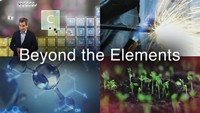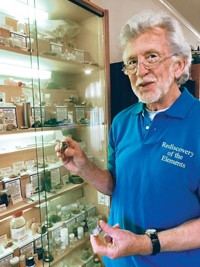Advertisement
Grab your lab coat. Let's get started
Welcome!
Welcome!
Create an account below to get 6 C&EN articles per month, receive newsletters and more - all free.
It seems this is your first time logging in online. Please enter the following information to continue.
As an ACS member you automatically get access to this site. All we need is few more details to create your reading experience.
Not you? Sign in with a different account.
Not you? Sign in with a different account.
ERROR 1
ERROR 1
ERROR 2
ERROR 2
ERROR 2
ERROR 2
ERROR 2
Password and Confirm password must match.
If you have an ACS member number, please enter it here so we can link this account to your membership. (optional)
ERROR 2
ACS values your privacy. By submitting your information, you are gaining access to C&EN and subscribing to our weekly newsletter. We use the information you provide to make your reading experience better, and we will never sell your data to third party members.
Physical Chemistry
PBS Docudrama Brings Discovery Of The Chemical Elements To Life
Three-hour series, “The Mystery of Matter,” tells the tales of seven scientists with dramatic reenactments
by Bethany Halford
August 16, 2015
| A version of this story appeared in
Volume 93, Issue 32

In the world of science television, chemistry rarely gets a starring role. But for more than a decade, filmmaker Stephen Lyons has been working to bring the stories of chemistry’s pioneers and their groundbreaking discoveries to life on the small screen. On Aug. 19, many PBS stations across the country will air the culmination of that effort, “The Mystery of Matter: Search for the Elements.”
The three-hour broadcast uses dramatic reenactments, expert interviews, animation, and narration to tell the story of seven scientists and their work. The series begins with Joseph Priestley, Antoine Lavoisier, and the discovery of oxygen. Chemistry giants Humphry Davy, Dmitri Mendeleev, Marie Curie, and Harry Moseley each get their own tale. And the show finishes with Glenn Seaborg’s groundbreaking research on transuranic elements.
“It’s the story of how the elements came about through the contributions of these seven different people,” Lyons tells C&EN. “Obviously, we’ve glossed over quite a bit and not mentioned lots and lots of people, but we decided that it would make a more interesting series if we focused on a few individuals because it gave each of them time to emerge as a full-blown character.”
Lyons is no stranger to making movies about chemists. His 2007 NOVA documentary, “Forgotten Genius,” about chemist Percy Julian won the American Association for the Advancement of Science’s Science Journalism Award and the National Association of Science Writers’ Science in Society Award.
As project director, writer, producer, and codirector on “The Mystery of Matter,” Lyons had to delve into the details of these scientists’ lives, using their writings to construct scripts and researching what their laboratories and equipment looked like to build sets and replicas. For example, he commissioned specialty scientific equipment maker Jim Morris, from Antiques of Science & Technology, to re-create the long X-ray tube Moseley used to establish the atomic number’s importance in the periodic table.
Writing a compelling script that showed the characters’ lives in the lab proved tough, says “The Mystery of Matter” codirector Muffie Meyer. “Film for television has to be informative and entertaining,” she explains. “Finding experiments these scientists did that are visually understandable to an audience and, for lack of a better word, ‘sexy’ enough to be entertaining was challenging. It’s really hard when you get to Seaborg, where everything happens inside a cyclotron.”
Emmy Award-winning actor Michael Emerson, who appeared in the television series “Lost,” hosts “The Mystery of Matter.” Lyons had originally hoped to have a chemist host the series (C&EN, March 12, 2012, page 80). But he ultimately decided on an actor to draw in viewers who might not be primed to watch a chemistry program and to film the host’s scenes—many of which involve chemistry demonstrations—quickly and efficiently.
“The Mystery of Matter” premiered last year on Oregon Public Broadcasting, airing in one-hour segments over the course of three weeks. Although ratings were low for the first week, Lyons says positive buzz drew more viewers for the second and third weeks. The show was one of the station’s highest-rated programs for the 10 PM time slot in 2014.
When production on the show wrapped, Lyons and his colleagues realized they had accumulated an incredible resource—hours of footage, more than 100 animations, a multitude of interviews and photographs—much of which didn’t make it into the three-hour series. “Rather than let it sit on our shelf where no one can see it, we decided to take the material and create an educational resource,” Lyons says.
Through grants from several foundations, they’ve created a series of short videos for chemistry teachers to use. Some will be available on pbs.org/mysteryofmatter, and others will go up on a stand-alone website later this year. “In a way, the television series is just the beginning of the life of the project,” Lyons says. “I’m hoping that teachers will continue to use this material forever.”
Lyons also says there may be more episodes in store for “The Mystery of Matter.” “All we’ve really revealed in this series is how the elements were discovered,” he notes. “We recognize there’s a whole lot more to the mystery of matter than the question ‘What are the elements?’ There’s still the question of how do these elements combine with each other to form all the things we see around us. That’s another good story that maybe we’ll get to tell someday.”





Join the conversation
Contact the reporter
Submit a Letter to the Editor for publication
Engage with us on Twitter